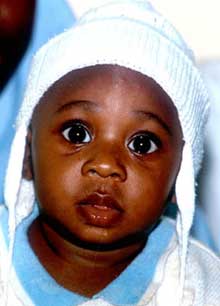Modus operandi: how satellites track a mass killer

Baby suffering from malaria <br>Photo: WHO/Pierre Virot 2001
A global mass killer could be tamed with the aid of satellite technology. Scientists are using data from Meteosat to help model and predict outbreaks of malaria. “Satellite sensor data hold out hope for the development of early-warning systems for diseases such as malaria, which kills between 1 and 2 million people each year,” says David Rogers, of Oxford University’s Department of Zoology.
Rogers is part of a team based in Oxford, Nairobi and at NASA’s Goddard Space Flight Center, Maryland, who are using Meteosat and other satellite climate data to create mathematical models of the prevalence and spread of malaria, and the dynamics of outbreaks of the disease.
“Malaria takes its greatest toll in sub Saharan Africa,” explains Rogers, “but the failure of affordable drugs, population growth and poverty are all contributing to a steady increase in the scale of the problem.” It is against this background that interest in using satellite surveillance to map and predict malaria outbreaks is growing.
Malaria is a parasitic disease, spread by mosquitoes from infected to healthy people. With today’s satellite technology, scientists now have the ability to map climate conditions with the kind of detail and timeliness required to model the behaviour of the parasite’s mosquito vectors.
“Mosquito populations can grow and collapse in a few days,” explains Rogers, “and some species live in very small pools of water – even in up-turned coconut shells – so we really need all the temporal and spatial resolution we can get. One of my colleagues once suggested we needed a ’Puddle-sat’ to identify mosquito breeding areas.”
Several climate factors affect the mosquito population. David Rogers explains: “Temperature, humidity and rainfall are all important to mosquitoes at different stages of their life cycle but the relative importance of each varies in different places. In cold places, temperature limits the population and water generally doesn’t. In warmer places temperature is usually not limiting but water may be. In the hottest of places, all three factors tend to be limiting.”
The team has been searching for the best correlation between climate factors and the incidence of malaria. The situation is complicated by the fact that the relationship between the number of mosquitoes and the number of cases of malaria is not a simple one; the inherent resistance or immunity of the local people to the disease varies in cycles and the reporting and recording of actual cases of infection on the ground is patchy at best.
To help deal with this problem, the team have found that a measure of plant growth is in fact very well matched to reported cases of malaria in many locations in East Africa, so perhaps that index can be used to ’fill in the gaps’ in the patchy medical data.
The team believe they have now begun to see some clear patterns emerging in the correlation of Meteosat cloud and rainfall data and malaria outbreaks, as a paper in the journal Nature, published last week explains. But, adds David Rogers “no prediction is ever 100% correct, so we see our work as progressively approximating the real situation on the ground in a continuing loop – make a prediction, check it on the ground, find and investigate wrong predictions and make a better model.”
With climate change threatening to change the prevalence of diseases like malaria, it is more important than ever to develop good techniques for predicting their behaviour. “It is clear that the technologies we now have to study these diseases are far better than those available to malariologists in the early years of the last century. The challenge is to make the science of malaria prediction at least as good,” concludes David Rogers. “All epidemiologists are looking forward to the greater information content of Meteosat SecondGeneration (MSG) data”.
The first MSG, developed by ESA in cooperation with EUMETSAT, will be launched by EUMETSAT this summer.
Media Contact
All latest news from the category: Health and Medicine
This subject area encompasses research and studies in the field of human medicine.
Among the wide-ranging list of topics covered here are anesthesiology, anatomy, surgery, human genetics, hygiene and environmental medicine, internal medicine, neurology, pharmacology, physiology, urology and dental medicine.
Newest articles

First-of-its-kind study uses remote sensing to monitor plastic debris in rivers and lakes
Remote sensing creates a cost-effective solution to monitoring plastic pollution. A first-of-its-kind study from researchers at the University of Minnesota Twin Cities shows how remote sensing can help monitor and…

Laser-based artificial neuron mimics nerve cell functions at lightning speed
With a processing speed a billion times faster than nature, chip-based laser neuron could help advance AI tasks such as pattern recognition and sequence prediction. Researchers have developed a laser-based…

Optimising the processing of plastic waste
Just one look in the yellow bin reveals a colourful jumble of different types of plastic. However, the purer and more uniform plastic waste is, the easier it is to…



